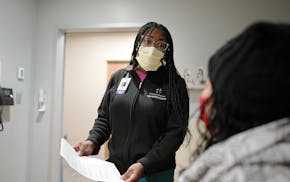Wells Fargo will rebuild its arson-destroyed site at Lake Street and Nicollet Avenue with a 200-plus unit residential building, bank branch and commercial space, developed by Project for Pride in Living, the developer-manager of affordable housing.
The 2.5-acre project being announced Monday will be worth more than $50 million, or 10% of the estimated $500 million in destruction to properties in Minneapolis and St. Paul from vandalism and arson in the wake of protests to the death of George Floyd in police custody last summer.
"The destruction of our bank and businesses on the Lake Street corridor was traumatic for our team and many in this neighborhood," said Laurie Nordquist, Wells Fargo's Minneapolis-based regional president. "PPL brought creativity in thinking and commitment to this process that will allow Wells Fargo to continue serving banking needs of our customers while also putting the site to more uses that benefit our neighbors."
Construction is due to begin next year on the first phase, which will feature a new Wells Fargo branch and approximately 100 units of housing, commercial and community space. The development is planned as affordable in what is a working-class to low-income neighborhood.
PPL hired Design by Melo to lead the architectural work. And 35% of project expenditures will go toward employing a "diverse workforce" in construction. PPL will buy the site from Wells Fargo, which will remain involved in the planning and financing.
The development partners will retain Cultural Wellness Center, co-owner of the Midtown Global Market and a research organization, to lead a predevelopment planning process over four months. Interested parties can sign up for community and online meetings at lakeandnicollet.com.
"We see this as a new template for community development," said Paul Williams, chief executive of PPL. "We're not just buying the site, sizing it and building. We're working with Cultural Wellness Center to find out what the folks who live around there want, including community space and entrepreneurial space. We have a history of that."
The Wells Fargo branch, constructed in the 1950s as one of the larger branch banks of the former Norwest Corp., is on a historic corner that was previously the site of Nicollet Park, a minor league baseball stadium.
The property, with exception of an apartment strip along Lake Street, was a big parking lot and drive-through ATMs connected to the branch bank. After the site was burned last summer, the remains were demolished last month.
The 20-employee branch had been a busy place, serving a growing small-business community and consumers in a neighborhood of predominantly Latino and African immigrants. Much of the second-floor office space was little used, however.
"We are going to focus on affordable housing, minority small businesses specifically and small business generally, and the financial health of customers and our communities," said Nordquist, ticking off additional investments Wells Fargo plans. "We will be part of significant and positive change."
Wells Fargo also plans to move into leased, larger space near Hiawatha Avenue from a damaged office.
City officials, who are eager to rebuild extensive damage on Lake Street, expressed cautious optimism.
"This is a great opportunity for Wells Fargo to reinvest in the community," said Erik Hansen, the Minneapolis economic development director. "This is the kind of development that is needed as long as [it] looks like the people in that neighborhood and doesn't accelerate displacement of people who live around there. And Wells Fargo is going with a community developer and not just selling the land to the high bidder."
Wells Fargo, based in San Francisco and New York, was a leading offender in the subprime mortgage debacle that led to the 2008 recession that badly damaged inner-city neighborhoods, including Minneapolis. More recently, Wells Fargo floundered after a scandal over fake customer accounts that led to billions of dollars in fines and settlements, cost two successive CEOs their jobs and disgraced board members.
City officials contend redevelopment in riot-damaged parts along Lake Street and West Broadway is hamstrung by low land values. They have proposed, with colleagues in St. Paul, a $300 million loan fund to help close the gap between owner equity and what commercial lenders will finance.
The DFL-majority House of Representatives has included the fund in its fiscal 2022-23 budget. Gov. Tim Walz budgeted a smaller amount. The Republican-majority Senate has included a $100 million loan guarantee fund that Hansen said demonstrates "progress" after an initial rejection. Minneapolis has committed $8 million through such a fund for a number of pending development deals involving local business owners.
The Minneapolis-area business community generally supports state assistance. A recent Greater Minneapolis Regional Chamber of Commerce-funded study shows the city over the last 15 years has sent about $3.50 in tax dollars to the state for every $1 it gets in state aid.
Lake Street is starting to rebuild, thanks largely to private investment, insurance proceeds, and about $10 million in grants to small businesses through the Lake Street Council, which is backed by individual and corporate donors. Most of the rubble has been hauled away and boarded windows fixed.
"For the most part, Lake Street feels like itself again," Allison Sharkey, executive director of the Lake Street Council, said recently.
Still, hundreds of businesses remain closed and dozens of small buildings boarded or demolished.

St. Anthony: 'Patient' investing paying off for St. Paul's Hill Capital

Jennifer Smith, leader of Burnsville's Innovative Office Solutions, has died

St. Anthony: Medical professions in Minnesota need more people of color in their ranks


